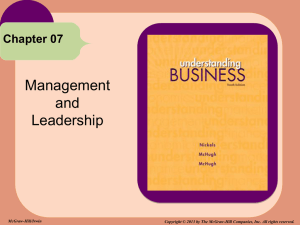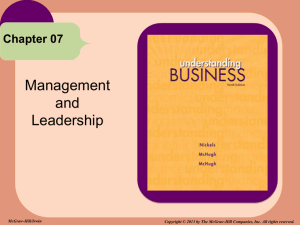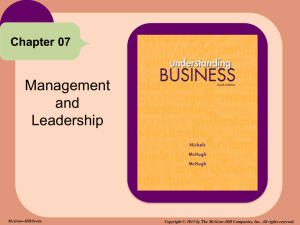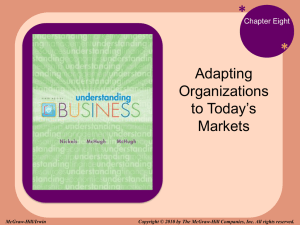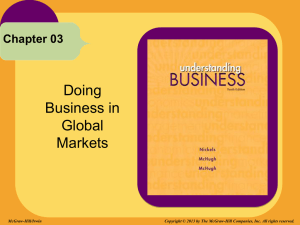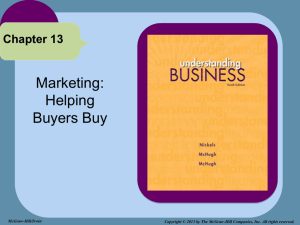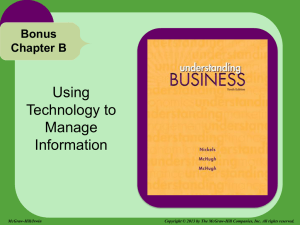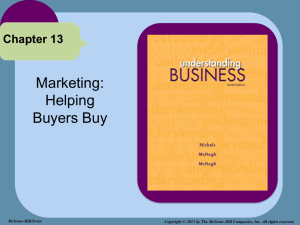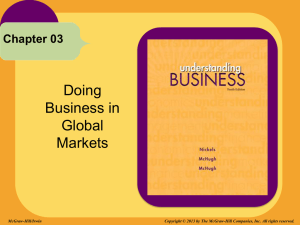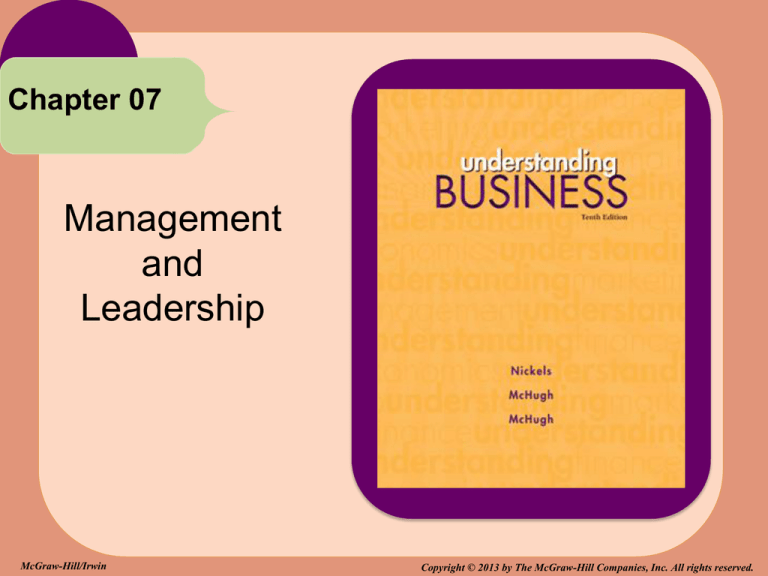
Chapter 07
Management
and
Leadership
McGraw-Hill/Irwin
Copyright © 2013 by The McGraw-Hill Companies, Inc. All rights reserved.
Chapter Seven
LEARNING GOALS
1. Describe the changes occurring today in the
management function.
2. Describe the four functions of management.
3. Relate the planning process and decision making
to the accomplishment of company goals.
7-2
Chapter Seven
LEARNING GOALS
4. Describe the organizing function of management.
5. Explain the differences between leaders and
managers, and describe the various leadership
styles.
6. Summarize the five steps of the control function of
management.
7-3
Profile
JOHN MACKEY
Whole Foods Market
• Worked at a vegetarian co-op
after attending the University
of Texas.
• Opened SaferWay Natural
Foods with his girlfriend
before merging with a
competitor to create Whole
Foods.
• Now there are over 300
stores in the U.S. and U.K.
7-4
Chapter Seven
NAME that COMPANY
Like many companies today, this company uses
social media to communicate with customers.
In one case, a customer complained on Twitter
when the company sent a Blackberry to replace
an iPhone that failed. The company responded
quickly with a replacement iPhone. The
customer then tweeted about the company’s
great customer service.
Name that company!
7-5
Four Functions
of Management
WHAT IS MANAGEMENT?
LG1
• Management -- The process used to accomplish
organizational goals through planning, organizing,
leading and controlling people and other
organizational resources.
7-6
Managers’ Roles
Are Evolving
TODAY’S MANAGERS
LG1
• Younger and more
progressive.
- Growing numbers of women.
- Fewer from elite universities.
• Emphasis is on teams and
team building.
• Managers need to be skilled
communicators and team
players.
7-7
Managers’ Roles
Are Evolving
RESPECT and HOW to GET IT
LG1
Source: Entrepreneur, www.entrepreneur.com, accessed June 2011.
7-8
Managers’ Roles
Are Evolving
EDUCATION MATTERS
Alma Maters of CEOs
LG1
Rank
School
# of CEOs
Who?
1
University of California
12
William Johnson - Heinz
2
School of Hard Knocks*
12
Steve Jobs - Apple
3
Harvard College
11
Steve Ballmer - Microsoft
4
University of Missouri
11
David Novak - Yum! Brands
5
University of Texas
11
Gary Kelly - Southwest Airlines
6
University of Wisconsin
11
Carol Bartz - Yahoo!
7
Dartmouth College
10
Enrique Salem - Symantec
8
Princeton
8
Andrea Jung - Avon Products
9
Indiana University
8
Donald Knauss - Clorox
10
Purdue University
8
Gregory Wasson - Walgreen’s
* Did not graduate from any college or university.
Source: Bloomberg BusinessWeek, May 17, 2010.
7-9
Four Functions
of Management
LG2
FOUR FUNCTIONS of
MANAGEMENT
1. Planning
2. Organizing
3. Leading
4. Controlling
7-10
Progress
Assessment
PROGRESS ASSESSMENT
• What are some of the changes happening in
management today?
• What’s the definition of management used in this
chapter?
• What are the four functions of management?
7-11
Planning &
Decision Making
SHARING the VISION
LG3
• Vision -- More than a
goal, it’s a broad
explanation of why the
organization exists and
where it’s trying to go.
7-12
Planning &
Decision Making
DEFINING THE MISSION
LG3
• Mission Statement -- Outlines the organization’s
fundamental purposes. It includes:
-
The organization’s self–concept
Its philosophy
Long–term survival needs
Customer needs
Social responsibility
Nature of the product or service
7-13
Planning &
Decision Making
LG3
SETTING
GOALS and OBJECTIVES
• Goals -- The broad, long-term
accomplishments an
organization wishes to attain.
• Objectives -- Specific, shortterm statements detailing how
to achieve the organization’s
goals.
7-14
Planning &
Decision Making
LG3
PLANNING ANSWERS
FUNDAMENTAL QUESTIONS
• What is the situation now?
SWOT Analysis -- Analyzes the organization’s
Strengths, Weaknesses, Opportunities and Threats.
• How can we get to our goal from here?
-
Strategic planning
Tactical planning
Operational planning
Contingency planning
7-15
Planning &
Decision Making
SWOT MATRIX
LG3
7-16
Planning &
Decision Making
PLANNING FUNCTIONS
LG3
7-17
Planning &
Decision Making
LG3
STRATEGIC and TACTICAL
PLANNING
• Strategic Planning -- Done by top management
and determines the major goals of the organization
and the policies, procedures, strategies and
resources it will need to achieve them.
• Tactical Planning -- The process of developing
detailed, short-term statements about what is to be
done, who is to do it and how.
7-18
Planning &
Decision Making
LG3
OPERATIONAL and CONTINGENCY
PLANNING
• Operational Planning -- The process of setting
work standards and schedules necessary to
implement the company’s tactical objectives.
• Contingency Planning -The process of preparing
alternative courses of action
the firm can use if its primary
plans don’t work out.
7-19
JAPANESE CRISIS, TERRORISM,
and AMERICAN BUSINESS
(Reaching Beyond Our Borders)
• Disasters point out the need for contingency and
disaster planning.
• Over 30 U.S. corporations get at least 15% of
sales from Japan. All were affected by the
earthquake.
• Man-made disasters, such as war and terrorism,
also disrupt the supply chain.
7-20
Decision Making:
Finding the Best
Alternative
DECISION MAKING
LG3
• Decision Making -- Choosing among two or more
alternatives.
7-21
Decision Making:
Finding the Best
Alternative
WHAT MAKES a GREAT CEO
LG3
Decision Making Skills of Top CEOs
• Keep global business issues in mind and be a
citizen of the world.
• Identify and manage risks before they grow.
• Change strategies and models with the times.
• Skillfully manage relationships with governments
as government involvement rises.
Source: Fortune, June 13, 2011.
7-22
Decision Making:
Finding the Best
Alternative
LG3
RATIONAL DECISION-MAKING
MODEL
1. Define the situation.
2. Describe and collect needed information.
3. Develop alternatives.
4. Develop agreement among those involved.
5. Decide which alternative is best.
6. Do what is indicated.
7. Determine whether the decision was a good one
and follow up.
7-23
Decision Making:
Finding the Best
Alternative
PROBLEM SOLVING
LG3
• Problem Solving -- The process of solving the
everyday problems that occur; less formal than
decision making and needs quicker action.
• Problem-solving techniques include
brainstorming and PMI -- Listing all the pluses for a
solution in one column, all the minuses in another
and the implications in a third.
7-24
Progress
Assessment
PROGRESS ASSESSMENT
• What’s the difference between goals and
objectives?
• What does a company analyze when it does a
SWOT analysis?
• What are the differences between strategic,
tactical and operational planning?
• What are the seven Ds in decision making?
7-25
Organizing:
Creating a
Unified System
ORGANIZATIONAL CHARTS
LG4
• Organization Chart -A visual device that
shows relationships
among people and
divides the
organization’s work; it
shows who reports to
whom.
7-26
Organizing:
Creating a
Unified System
LEVELS of MANAGEMENT
LG4
7-27
Organizing:
Creating a
Unified System
MANAGEMENT LEVELS
LG4
• Top Management -- The highest level, consists
of the president and other key company executives
who develop strategic plans.
• Middle Management -- Includes general
managers, division managers, and branch and
plant managers who are responsible for tactical
planning and controlling.
• Supervisory Management -- Those directly
responsible for supervising workers and evaluating
daily performance.
7-28
Organizing:
Creating a
Unified System
TOP MANAGEMENT
LG4
• Chief Executive Officer (CEO)
- Introduces change into an organization.
• Chief Operating Officer (COO)
- Implements CEO’s changes.
• Chief Financial Officer (CFO)
- Obtains funds, plans budgets, collects funds, etc.
• Chief Information Officer (CIO)
- Gets the right information to the right people so
decisions can be made.
7-29
Organizing:
Creating a
Unified System
LG4
AMERICA’S MOST POWERFUL
FEMALE MANAGERS
Rank
Name
Organization
1
Indra Nooyi
PepsiCo
2
Irene Rosenfeld
Kraft Foods
3
Patricia Woertz
Archer Daniel Midland
(ADM)
4
Angela Braly
WellPoint
5
Andrea Jung
Avon Products
6
Oprah Winfrey
Harpo and OWN
7
Ellen Kullman
DuPont
8
Ginni Rommetty
IBM
9
Ursula Burns
Xerox
10
Carol Bartz
Yahoo!
Source: Fortune Magazine, www.fortune.com, accessed June 2011.
7-30
Tasks and Skills
at Different Levels
of Management
MANAGERIAL SKILLS
LG4
• Technical Skills -- The ability to perform tasks in a
specific discipline or department.
• Human Relations Skills -- Skills that involve
communication and motivation; they enable
managers to work through and with people.
• Conceptual Skills -- Skills that involve the ability to
picture the organization as a whole and the
relationship among its various parts.
7-31
Tasks and Skills
at Different Levels
of Management
LG4
THANK YOU
The Most Basic Human Relations Skill
• Saying “thank you” has led to happier employees
and greater profits for companies.
• Whom should a manager thank?
1. Interns - Doing lots of work for little money, they are
the future of the company and industry.
2. Lawyers - Many do pro bono work, even for nonprofit
companies.
3. The little people - Mailroom, repair, and cleaning staff
keep the office running day-to-day.
Source: Fast Company, November 2010.
7-32
Tasks and Skills
at Different Levels
of Management
LG4
SKILLS NEEDED at VARIOUS
LEVELS of MANAGEMENT
7-33
Staffing: Getting
and Keeping the
Right People
STAFFING
LG4
• Staffing -- Recruiting, hiring, motivating and
retaining the best people available to accomplish the
company’s objectives.
• Recruiting good
employees is critical.
• Many people are not
willing to work at
companies unless they
are treated well with
fair pay.
7-34
Staffing: Getting
and Keeping the
Right People
STAFFING is TRICKY BUSINESS
LG4
Six Sins of Staffing
1. Don’t hire someone because someone else says so.
2. Don’t get caught up in applicants’ appearances.
3. Don’t give someone the wrong job.
4. Don’t forget about feedback.
5. Don’t give promotions just because it’s time.
6. Don’t cheat your employees.
Source: CareerBuilder, www.careerbuilder.com, accessed June 2011.
7-35
Leading: Providing
Continuous Vision
and Values.
LEADERSHIP
LG5
• Leaders must:
- Communicate a vision
and rally others around
that vision.
- Establish corporate
values.
- Promote corporate
ethics.
- Embrace change.
- Stress accountability and
responsibility.
7-36
To SHARE or NOT to SHARE
(Making Ethical Decisions)
As a first-line manager, you have new information
that your department head hasn’t seen yet. The
findings of the report indicate your manager’s
plans should fail. If they do fail, you could be
promoted.
Will you give your department head the report?
What is the ethical thing to do?
What might be the consequences?
7-37
Leading: Providing
Continuous Vision
and Values.
LG5
ACCOUNTABILITY through
TRANSPARENCY
• Transparency -The presentation of
the company’s facts
and figures in a way
that is clear and
apparent to all
stakeholders.
7-38
Leadership
Styles
LEADERSHIP STYLES
LG5
• Autocratic Leadership -Making managerial decisions
without consulting others.
• Participative or Democratic
Leadership -- Managers and
employees work together to
make decisions.
• Free-Rein Leadership -Managers set objectives and
employees are free to do
whatever is appropriate to
accomplish those objectives.
7-39
Leadership
Styles
VARIOUS LEADERSHIP STYLES
LG5
7-40
Leadership
Styles
NATURAL BORN LEADERS?
Four Types of Executives
LG5
Rationalists
Humanists
Politicists
Culturists
Source: CIO Magazine, www.cio.com.
7-41
USING SOCIAL MEDIA to
BUILD CUSTOMER SUPPORT
(Social Media in Business)
• Many companies use sites like Twitter and
Facebook to proactively and reactively
communicate with their customers.
• Best Buy has 2,500 employees who read and
respond to consumer complaints on Twitter.
• Many companies still aren’t implementing these
programs. This has led to many more complaints
via social media than positive support.
7-42
Empowering
Workers
EMPOWERMENT
LG5
• Progressive leaders give employees the
authority to make decisions on their own without
consulting a manager.
• Customer needs are handled quickly.
• Manager’s role becomes less of a boss and
more of a coach.
• Enabling -- Giving workers the education and tools
they need to make decisions.
7-43
Empowering
Workers
LG5
WORK SMARTER
How to Ease Pressure on Workers
• Manage output instead of hours.
• Train workers to be ready for a more complex
corporate structure.
• Allow lower-level managers to make decisions.
• Use new technology to foster teamwork.
• Shift hiring emphasis to collaboration.
Source: Bloomberg BusinessWeek, www.businessweek.com.
7-44
Managing
Knowledge
MANAGING KNOWLEDGE
LG5
• Knowledge Management -Finding the right information,
keeping the information in a
readily accessible place and
making the information known
to everyone in the firm.
• Tries to keep people from
reinventing the wheel.
7-45
Controlling:
Making Sure it
Works
FIVE STEPS of CONTROLLING
LG6
7-46
Controlling:
Making Sure it
Works
ARE YOU a MICROMANAGER?
LG6
• Do you have strategic initiatives that you have
not addressed?
• Do you often check on employees for quality
control?
• Do you often check on subordinates throughout
the day?
• Do you rarely take vacations?
• Is there a lot of turnover?
Source: CFO Magazine, www.cfo.com.
7-47
A Key Criterion
for Measurement:
Customer
Satisfaction
MEASURING SUCCESS
LG6
• Traditional forms of measuring success are
financial.
• Pleasing employees, stakeholders and customers
is important.
• External Customers -- Dealers, who buy products
to sell to others, and ultimate customers (or end
users), who buy products for their own use.
• Internal Customers -- Individuals and units within
the firm that receive services from other individuals or
units.
7-48
Progress
Assessment
PROGRESS ASSESSMENT
• How does enabling help achieve empowerment?
• What are the five steps in the control process?
• What’s the difference between internal and
external customers?
7-49

